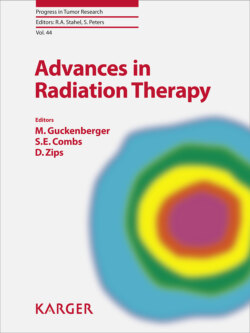Читать книгу Advances in Radiation Therapy - Группа авторов - Страница 35
На сайте Литреса книга снята с продажи.
Hypoxia and Radioresistance
ОглавлениеSeveral mechanisms can explain the lack of radiosensitivity in hypoxic tumors. Firstly, the effect of DNA damage induced by radiotherapy depends on the presence of oxygen. While DNA damage induced by free radicals can be restored in hypoxic areas, in the presence of oxygen the damage becomes permanent and irreparable. In other words, oxygen fixates the damage, and therefore this mechanism is called the oxygen fixation hypothesis (Fig. 3). The oxygen fixation hypothesis contributes to the so-called oxygen enhancement ratio (OER), which indicates that cells are 2–3 times more radiosensitive in the presence of oxygen relative to the absence of oxygen. The maximum of the OER curve lies at pO2 >10–15 mm Hg, above which the radiosensitivity does not increase much further. At a pO2 of about 2–5 mm Hg, the OER is reduced to about half the maximum level [19].
Secondly, tumor cells adopt a number of programs to survive a detrimental hypoxic microenvironment, which include hypoxia-inducible factor (HIF)-induced gene expression, the unfolded protein response (UPR) and – thereby among others – autophagy and mammalian targeting of rapamycin (mTOR) [20]. These programs are all directed to the survival of (tumor) cells under metabolic stress and lead to apoptosis resistance, increased metastasis, and increased genomic stability, etc. Additionally, the HIF-1 regulation of glycolysis and the pentose phosphate pathway lead to an aberrant cellular metabolism that increases the antioxidant capacity of tumors, thereby countering the oxidative stress caused by irradiation [21]. Finally, hypoxia will also lead to selection of particular tumor clones that are resistant to hypoxia-induced cell death. Combined with increased genomic imbalance, hypoxia will thus lead to the selection of more aggressive subclones, harboring p53 mutations, for example [22].
